As we mentioned here, we took a stopover in Queretaro, so it was a two-hour bus ride from there to Guanajuato. We knew we wanted to visit Guanajuato, but we had booked two weeks (instead of our usual one week) at an apartment here primarily because we got such a good price, and after a few weeks at resort towns along the beach, our budget needed a little TLC. By the time we arrived, we were so glad that we had two weeks of staying put in one place, after the hectic pace we’d been keeping since the first of the year; moving again after just one week was getting old. We were really looking forward to relaxing without feeling the pressure to get out and explore yet another sight or beach…okay, that definitely falls into the first world problem category.
Arriving in Guanajuato
Guanajuato is an old silver mining town built into a narrow valley. An interesting aspect of the town is its several tunnels, originally built to keep the river from flooding the town. The river has since been dammed, making the tunnels now an integral part of the traffic flow. Although the tunnels include narrow pedestrian walkways and are said to be safe, the number of pedestrians is limited, unlike the rest of the streets in town, which are generally crowded with people. The bus station in Guanajuato is quite a distance out of town, about a sixty peso* taxi ride, into the center. The route to our apartment was interesting and dramatic since it required traveling through three tunnels.
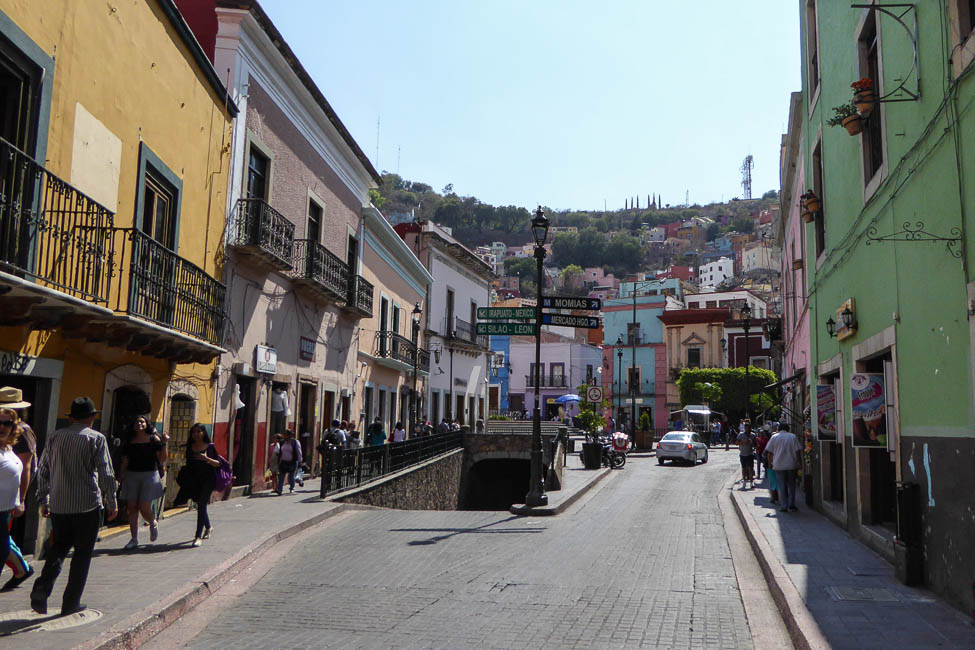
Arriving at our apartment, which we booked through Guanajuato Vacation Rentals, we found it to be one of the best equipped apartments that we’ve encountered. The furniture and bed were comfortable, the kitchen was well stocked (including plenty of paper goods!), we had hot water, and the crowning touch was that the sink had a built-in filtered water tap. No more dealing with hauling ten liter bottled water jugs from the store. Good thing given the elevation and hills! To top it off, this apartment was one of the better deals we’d found, $247 for a week (it would have been only $597 if we’d stayed for an entire month). A large grocery store was within about a 10 minute walk, and the centro area was about a 20 minute walk from the apartment, downhill going, and maybe just a little bit longer going back up.
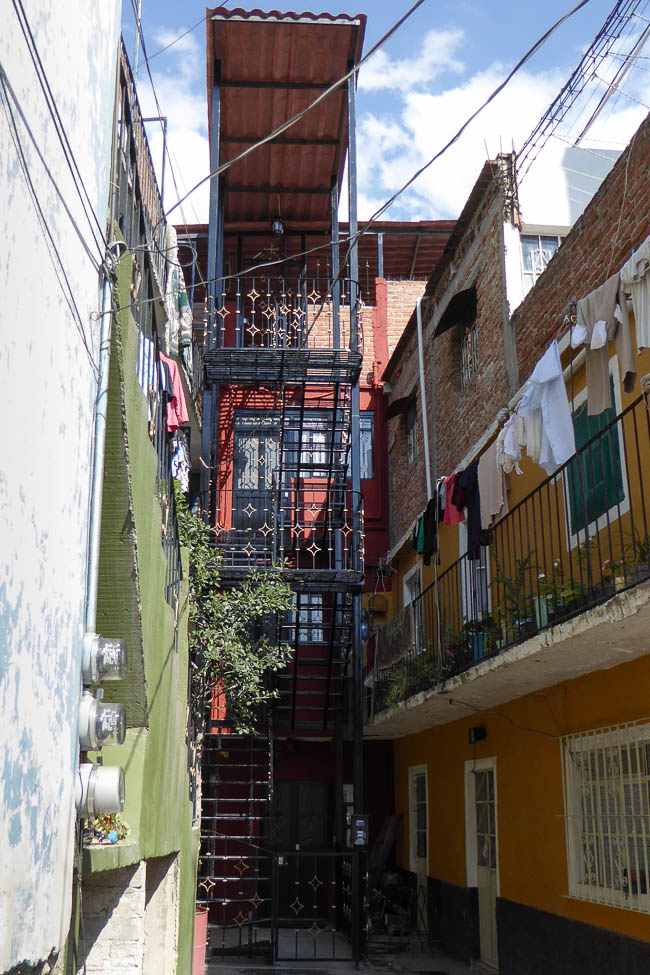
Exploring Guanajuato
Guanajuato is a colorful town with most living accommodations scaling up the sides of the hills which surround the town. Other than the main streets, which carry the traffic, a lot of the side streets are really alleys that cars cannot traverse. So getting around is primarily by foot. Which is good and bad. Good, lots of exercise, bad, remember those aforementioned hills, and the town is at 6500 ft. elevation. So our hearts were definitely pumping by the time we got back to our apartment every time we went out. We did take the local bus, 5 pesos each, on our last day, just for the experience.
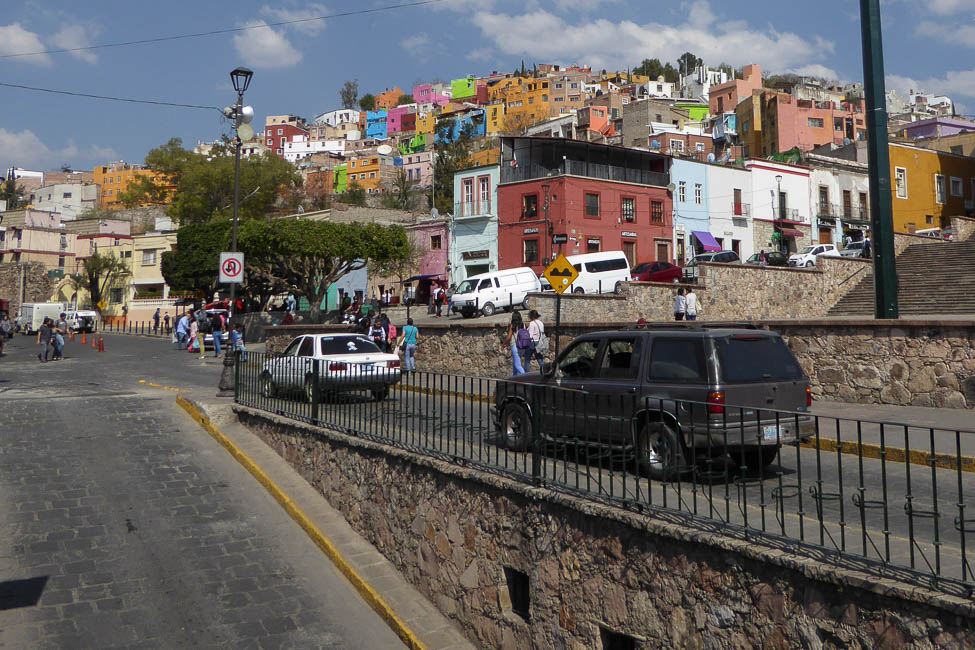
The three main streets in town are Calle Alhóndiga (north/south), Av. Benito Juárez (east/west), and Positos (east/west).
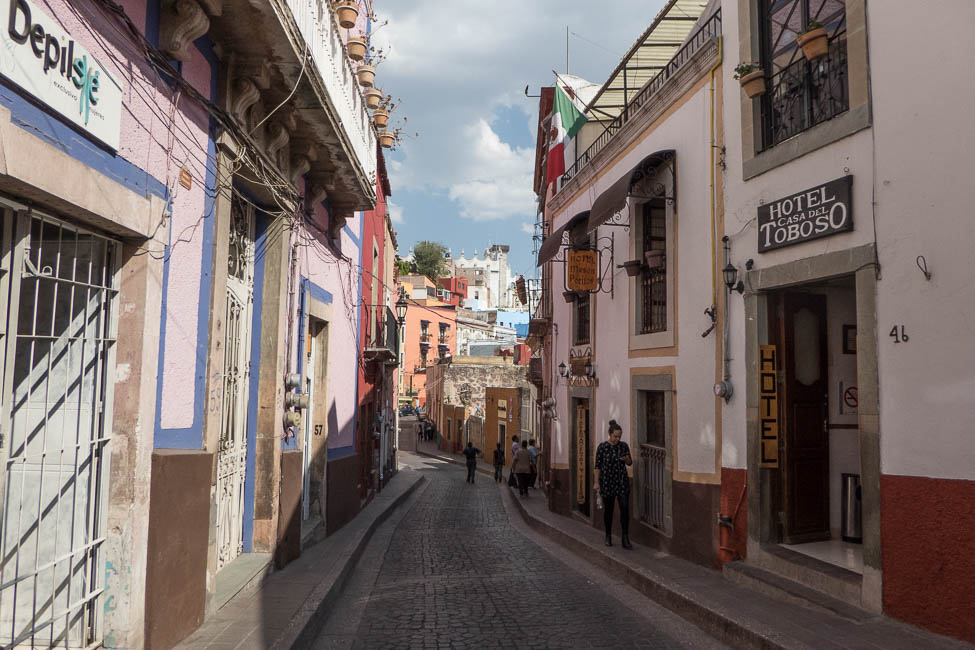
All of these streets change names along the way, which is confusing at first but then becomes natural. Calle Alhóndiga is mostly a business and residential street, with some hotels; Positos contains most of the museums and the University of Guanajuato,

as well as many hotels; Benito Juarez contains the Mercado and the Basilica Colegiata de Nuestra Senora de Guanajuato.
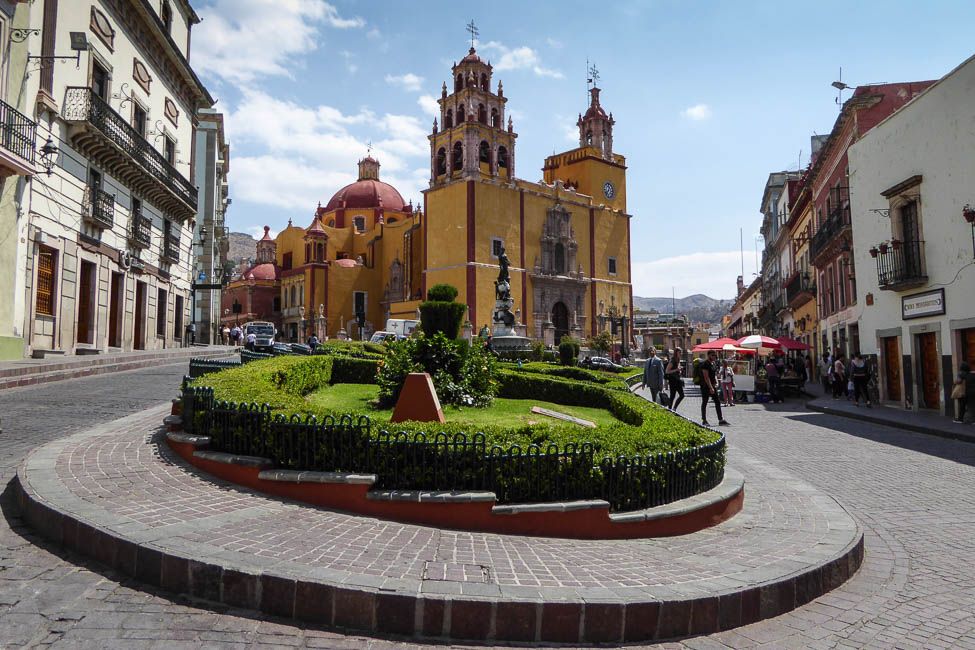
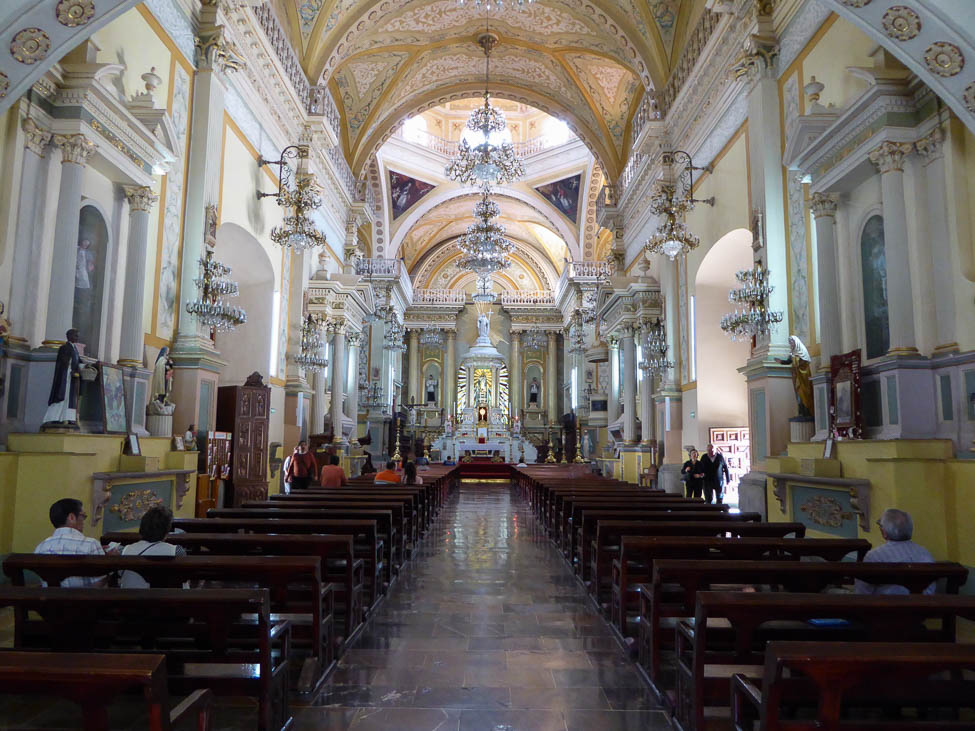
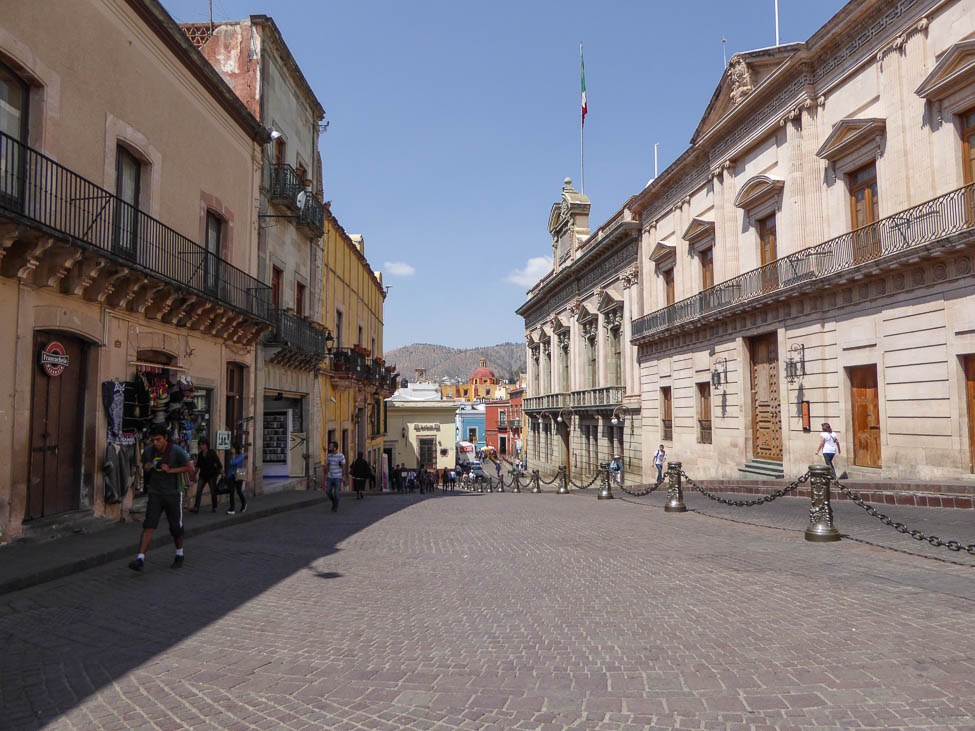
Close to the Basilica is Teatro Juarez, and a few blocks away is Teatro Principal, as well as several other old churches.
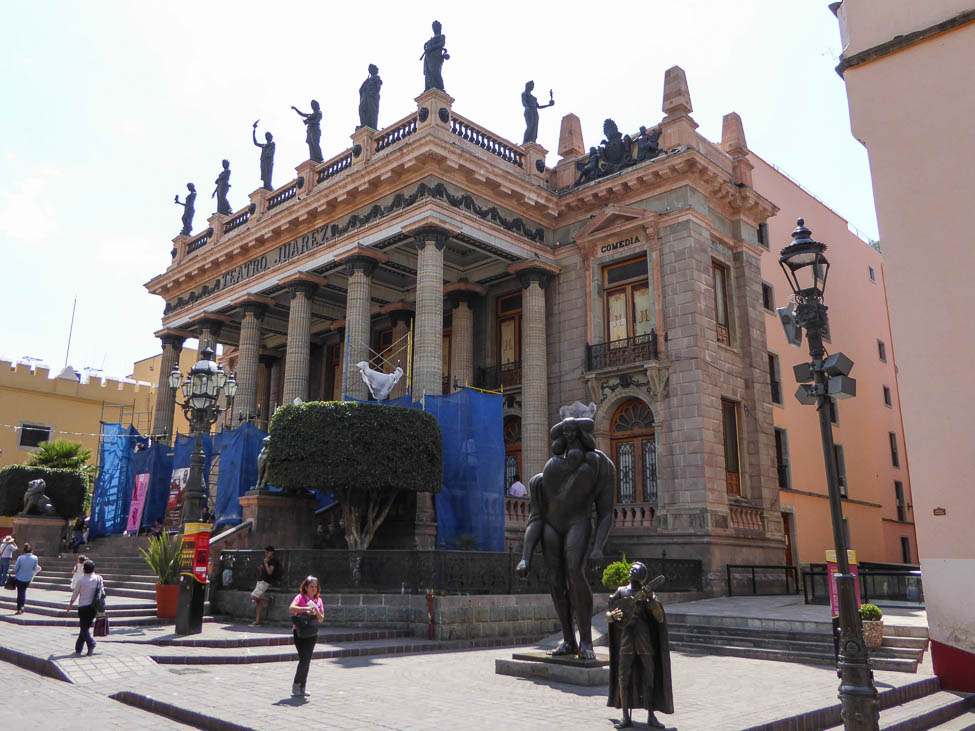


Because of the terrain, there are no large parks in Guanajuato. Instead it’s split up between a number of smaller parks and squares, including, to name just a few, Plaza de los Angeles, Plaza de San Roque, and Plaza de San Fernando (this one most favored by locals).
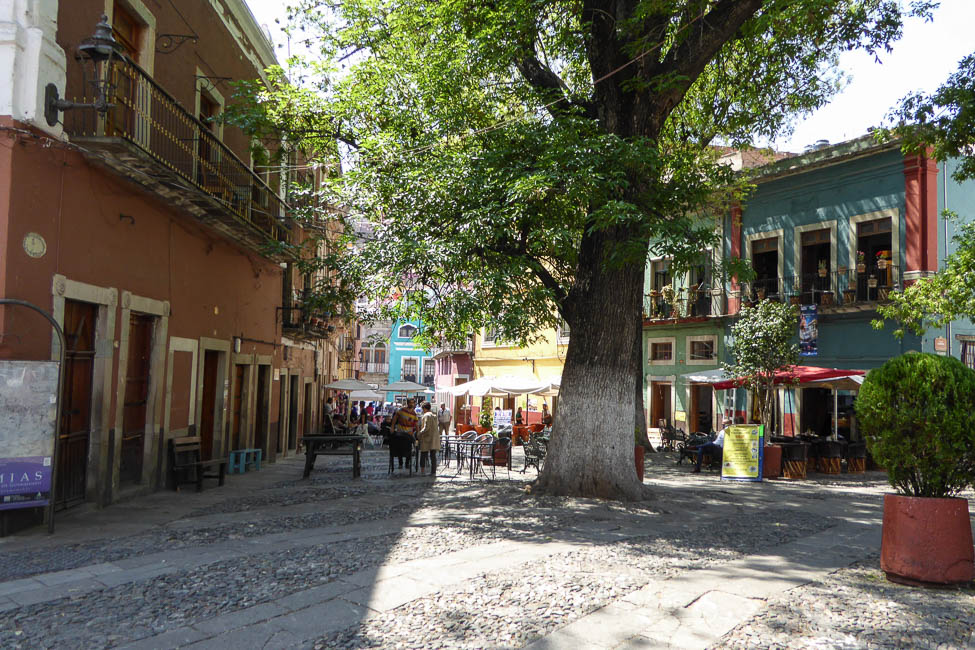
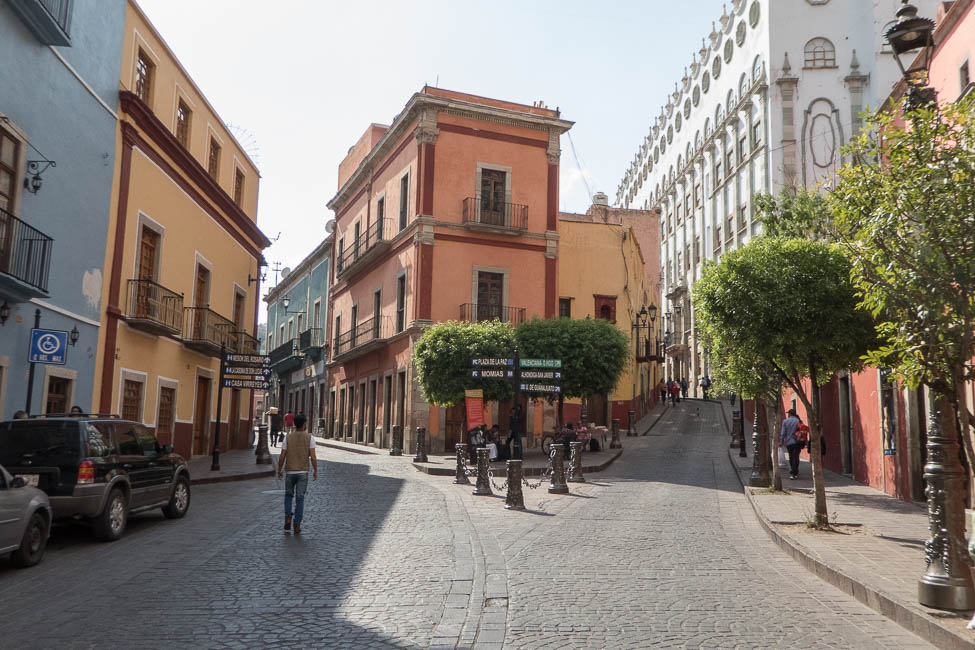
And Jardin de la Union, in the center of the city, with many restaurants and cafes and very lively at night.
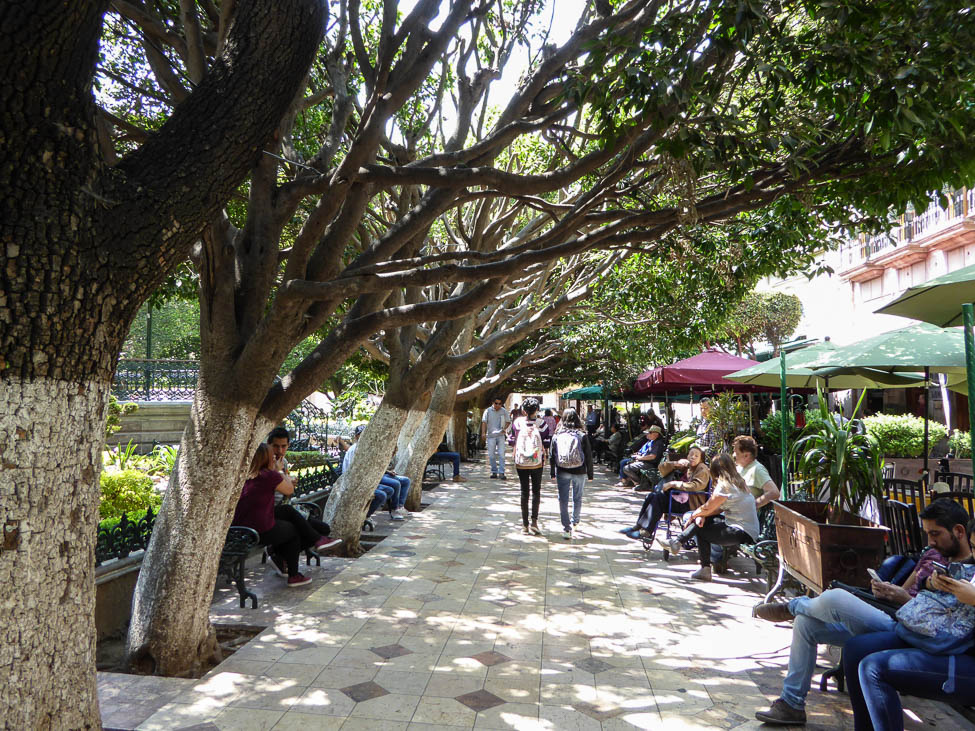
Our time in town was spent mostly relaxing and catching up from the frantic pace we had been keeping for the past few months. We did wander all around town almost every day, trying out a few different plazas for sitting and eating.
Two nights we went to performances at Teatro Juarez, one by the Symphony Orchestra of the University of Guanajuato, the other by the Classical Ballet Company of Mexico. The tickets were 100 pesos each for general admission, and we enjoyed the experiences. The quite ornate theatre is shaped like an Opera House, making for an intimate venue. And not bad for a bit more than $5 US each.

Wandering around town, we were struck at how few foreign tourists we saw, and also by how many local people of all ages are out and about at all hours of the day and night. Guanajuato, being a university town, also has lots of students. Some of these students dress as troubadours and lead tours during the evening.
Guanajuato is where Mexican artist Diego Rivera lived so there is a museum in and of his house, a hotel with his name, a taverna with his and Frida’s (Kahlo) name on it, in addition to numerous streets named after him.
In addition to Museo Casa Diego Rivera (which we did not visit), Guanajuato has numerous other museums covering a wide range of interests. We visited Museo del Pueblo del Guanajuato, a small museum in an old house with mostly work by local artists; admission was 25 pesos each.
One day, we ventured up to the top of a hill overlooking the city with the statue of El Pipila, a local hero from the time of the Mexican War of Independence. Ian thought that it looks a little like a Soviet era propaganda statue.
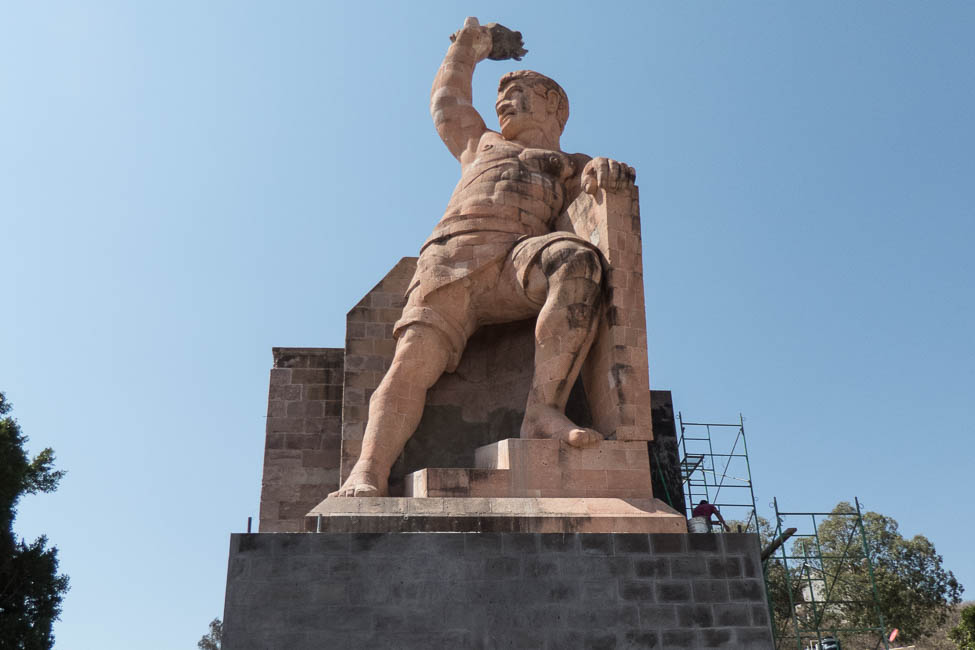
Walk or take the funicular? One way for 25 pesos, discount for round trip. Funicular up, walk down.
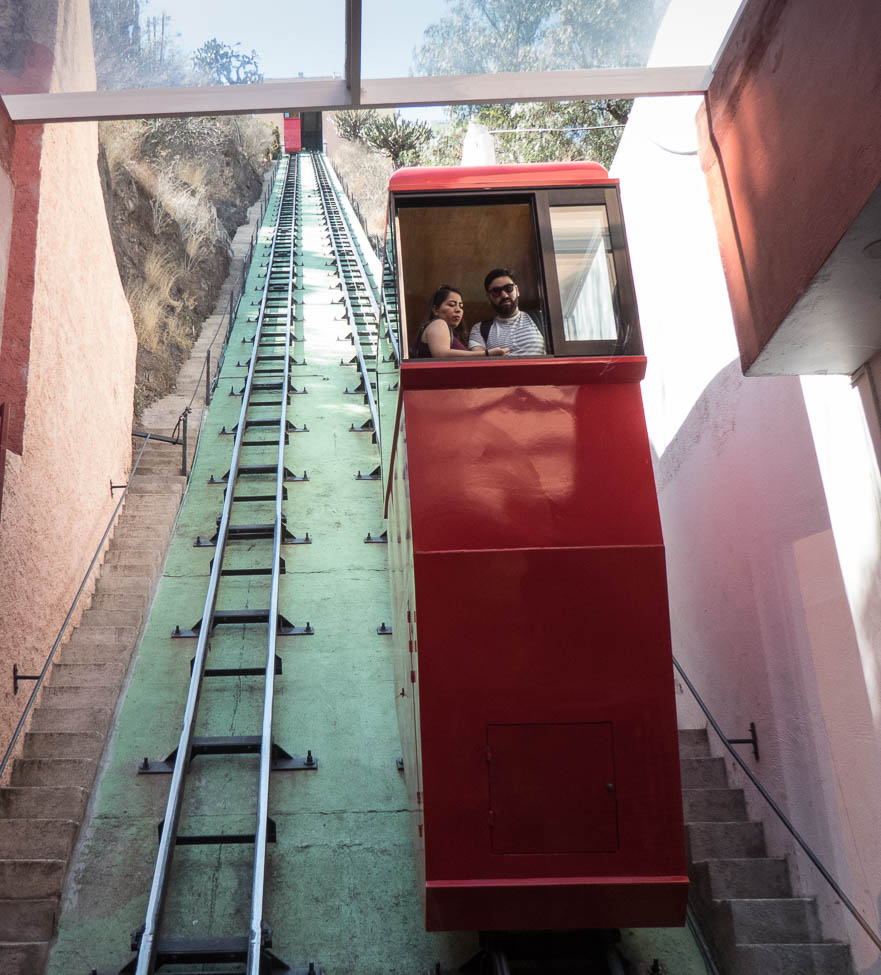
The view from the top is quite spectacular, and it’s a pleasant walk back down.
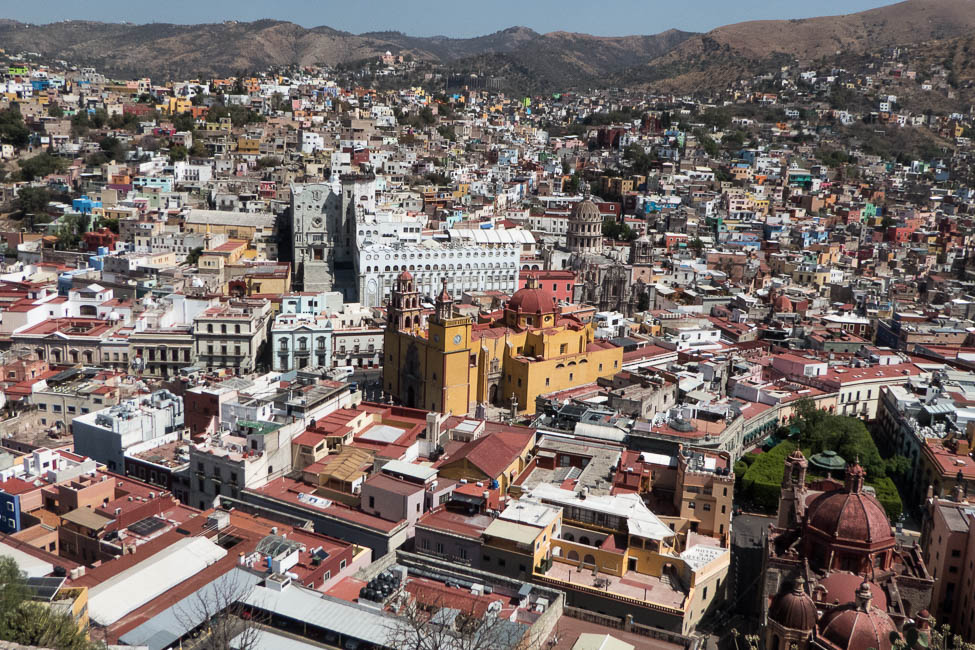
We were told that one can take different turn-offs on the way down, some of which dead end.
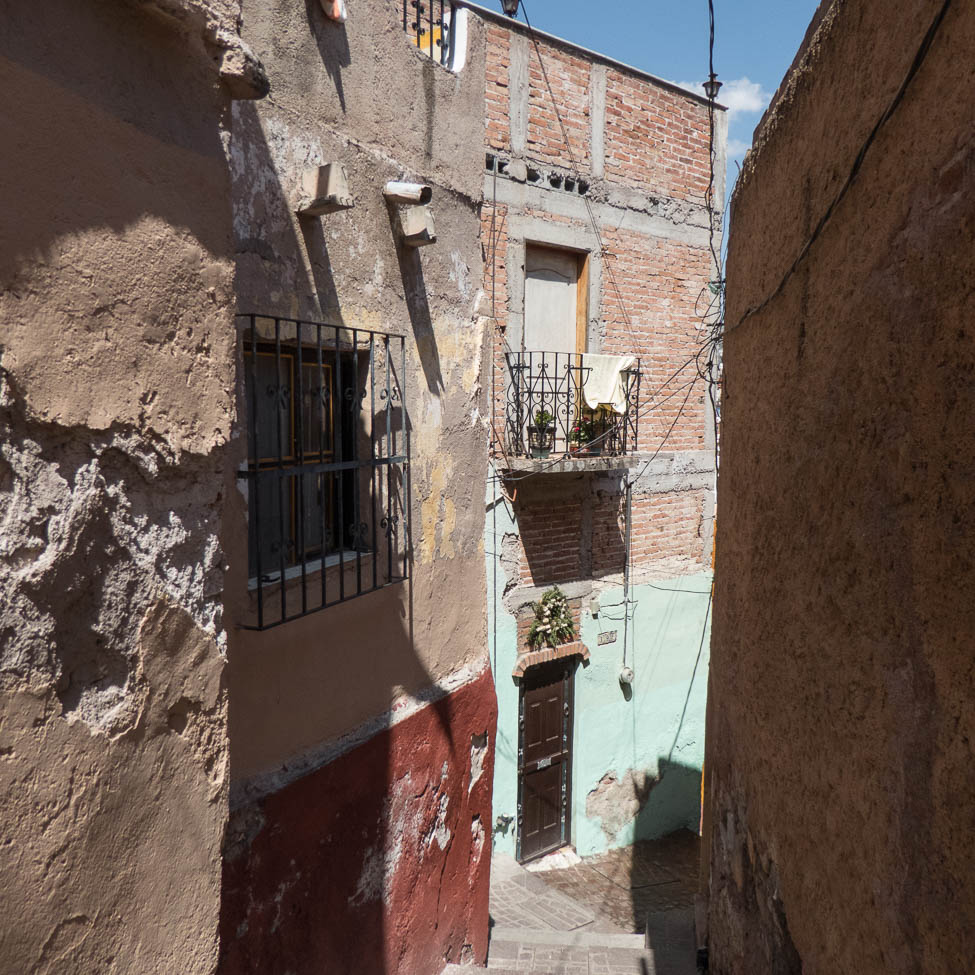
The whole two weeks that we had been walking around town, we saw signs everywhere we went pointing us to the Museo de Momias. So our last full day, we decided to visit, figured out where it was and set off walking from centro.

Turns out to be a bit further than it looks on Google Maps. In addition, as we got close to the museum, wouldn’t you know it, where’d the signs go? We made a couple of wrong turns and had to keep consulting Google Maps. At one point, Ann noticed a sign that gave the museum name and a picture of a person walking up stairs. Figuring that this must be a shortcut, we went that way. Big mistake! Way more steps than the 170 we did every day in Zihuatenajo, and did we mention the elevation? By the time we got to the top we were exhausted, but figured our efforts were not in vain: the stairs dead ended at a cemetery, and Google Maps showed the museum right behind the cemetery. Let’s just cut across…another big mistake. After wandering around inside the cemetery, we realized that a mausoleum surrounded three sides, thus preventing exit any way other than the way we entered. So back to the entrance and walk all the way around the outskirts of the cemetery. When we arrived and paid our entrance fee, we went inside and sure enough, the entire museum is walking around looking at mummies. These aren’t mummies such as the Egyptian ones; these occurred naturally, in various states of non-decay, some with faces that appeared to be in agony when they died. It is believed that at least one might have been buried alive, in a state possibly mistaken by doctors as dead. The mummies were discovered as bodies were exhumed when the cemetery (the one we wandered around) got full and needed extra space. Something in the soil or perhaps the dryness of the air kept the bodies remarkably well preserved. Apparently, Mexican law allows a body to be exhumed if it’s been buried for at least 5 years and no member of the family objects. And if the body is a mummy, then it belongs to the state, which in this case led to the creation of a museum. It was a little creepy.

Guanajuato Wrapup
In comparison to San Miguel de Allende, Guanajauto is a real town with a large and thriving population, including many students, and a much smaller expat and tourist population. Long term furnished rentals in Guanajuato could be found starting at $500 US per month. We met a couple who just rented a 2 BR top floor of a house for under $300 per month, in their words, in a rustic neighborhood.
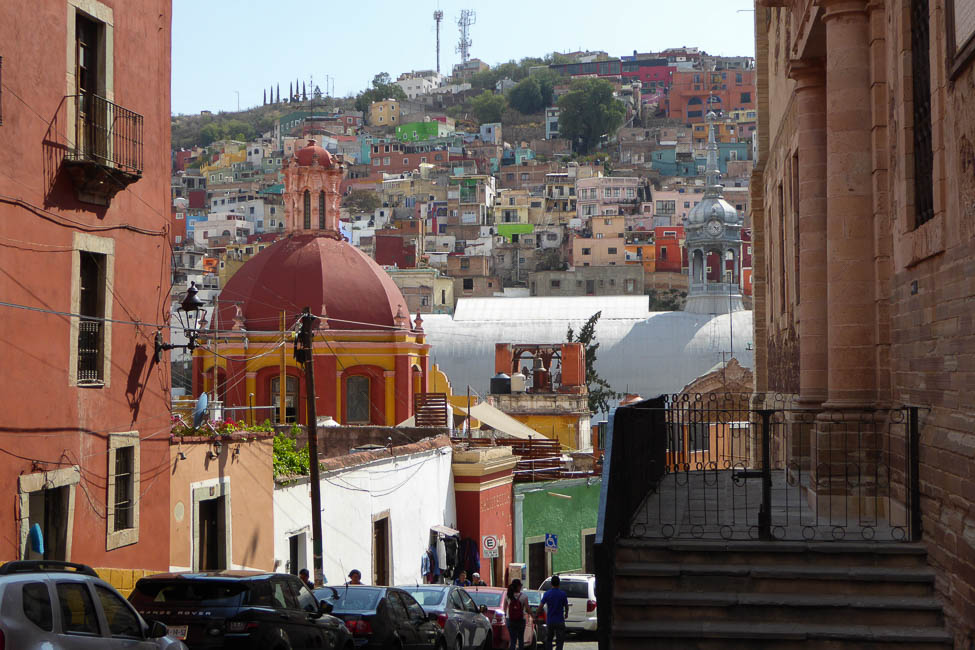
We really enjoyed our time in Guanajuato and would like to spend more time, perhaps coming back for a month. It might be a tough choice whether to come back here or spend more time in Queretaro, but of course, we only spent a day in Queretaro, so who knows?

*The exchange rate at time of writing was 18.5 Mexican pesos to the US dollar.
Next up: Ajijic and Lake Chapala

10 Comments
I’d like to visit Guanajuato from your photos and post.
Art said he visited there in his early 20’s (a long time ago…) and that the mummies were in the walls of the tunnels.
Interesting.
Thanks for your hard work.
Hi Sharona,
Yes, Guanajuato is definitely worth a visit. Not sure about the accuracy of Art’s recollections, Internet research yielding nothing about the mummies ever being in the tunnels, in a warehouse next to the cemetery, yes. 🙂
Ian & Ann
Yes indeed, I vividly remember the mummies of Gaunajuato from my student days in Mexico. I also recall that the town was one of my favorites as well. I am struck by how clean the streets appear to be from your pics. That was not my recollection. Also, when I was there in the late sixties the exchange rate was 8.5 pesos to the dollar… my how things have changed!
Hi Den,
Yes, the streets were actually relatively clean, especially compared to some of the other places we’ve visited in Latin America. And who knows what the exchange rate will do going forward?
Ian & Ann
That place sounds amazing!! I’d skip the mummies, ugh!! I’m a huge Diego and Frida fan so that would be cool. The altitude sounds challenging with all those hills. You both must have buns and legs of steel😃. When do you go to Europe? Safe travels. Love ya both😍
Hi Kathy,
No buns of steel yet but working on it. We leave for Europe on on a re-positioning cruise on 4/22 and arrive on 5/6.
Ian & Ann
The mummy museum sounds horrifying! Why would heir faces show agony, or any other feeling? I would think the muscles would relax on death. Yuk!
No mention of the food…
Hi Sue,
Yes, it was a bit gruesome, and no explanation about the expressions on the mummies’ faces.
Food: some yummy soup, mole, and Ian got his rotisserie chicken fix from three different places. Also had yummy Japanese food twice.
Ian & Ann
Hi — I love Guanajuato; thanks for the apt contrast between San Miguel de Allende and the REAL city of Guanajuato! I’m looking for a several day art workshop or class. They have lots in San Miguel. Do you know where to look for anything like that in Guanajuato:
Elizabeth
Hi Elizabeth,
Thank you for your comments and question. Guanajuato has an abundance of artsittic events. As far as an art workshop or class, we would suggest contacting the Arts Department at the University of Guanajuato and/or one or more of the several excellent museums. We would be interested to learn what you find.
Best of luck,
Ian and Ann